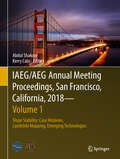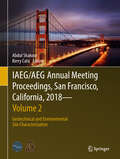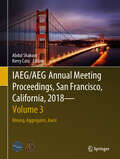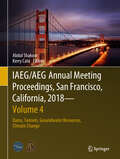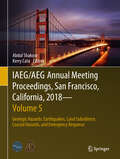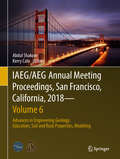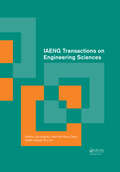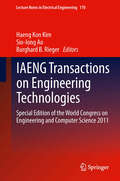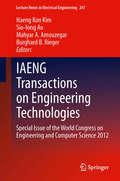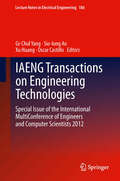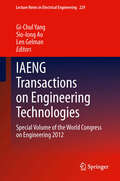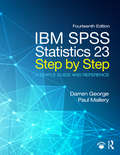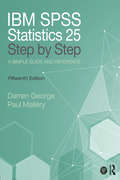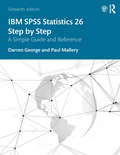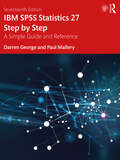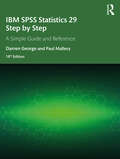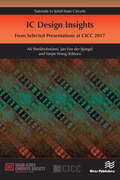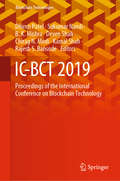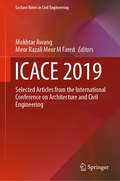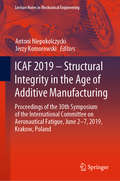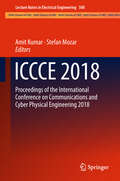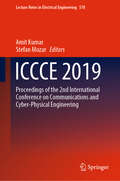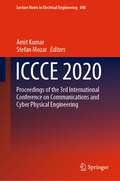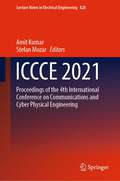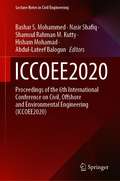- Table View
- List View
IAEG/AEG Annual Meeting Proceedings, San Francisco, California, 2018 - Volume 1: Slope Stability: Case Histories, Landslide Mapping, Emerging Technologies
by Abdul Shakoor Kerry CatoThis book is one out of six IAEG XIII Congress and AEG 61st Annual Meeting proceeding volumes, and deals with topics related to slope stability including case histories, landslide mapping, and emerging technologies. The theme of the IAEG/AEG Meeting, held in San Francisco from September 17-21, 2018, is Engineering Geology for a Sustainable World. The meeting proceedings analyze the dynamic role of engineering geology in our changing world. The meeting topics and subject areas of the six volumes are: Slope Stability: Case Histories, Landslide Mapping, Emerging Technologies; Geotechnical and Environmental Site Characterization; Mining, Aggregates, Karst; Dams, Tunnels, Groundwater Resources, Climate Change; Geologic Hazards: Earthquakes, Land Subsidence, Coastal Hazards, and Emergency Response; and Advances in Engineering Geology: Education, Soil and Rock Properties, Modeling.
IAEG/AEG Annual Meeting Proceedings, San Francisco, California, 2018 - Volume 2: Geotechnical and Environmental Site Characterization
by Abdul Shakoor Kerry CatoThis book is one out six IAEG XIII Congress and AEG 61st Annual Meeting proceeding volumes, and deals with topics related to the geotechnical and environmental site characterization. The theme of the IAEG/AEG Meeting, held in San Francisco from September 17-21, 2018, is Engineering Geology for a Sustainable World. The meeting proceedings analyze the dynamic role of engineering geology in our changing world. The meeting topics and subject areas of the six volumes are: Slope Stability: Case Histories, Landslide Mapping, Emerging Technologies; Geotechnical and Environmental Site Characterization; Mining, Aggregates, Karst; Dams, Tunnels, Groundwater Resources, Climate Change; Geologic Hazards: Earthquakes, Land Subsidence, Coastal Hazards, and Emergency Response; and Advances in Engineering Geology: Education, Soil and Rock Properties, Modeling.
IAEG/AEG Annual Meeting Proceedings, San Francisco, California, 2018 - Volume 3: Mining, Aggregates, Karst
by Abdul Shakoor Kerry CatoThis book is one out six IAEG XIII Congress and AEG 61st Annual Meeting proceeding volumes, and deals with topics related to mining, aggregates, and karst. The theme of the IAEG/AEG Meeting, held in San Francisco from September 17-21, 2018, is Engineering Geology for a Sustainable World. The meeting proceedings analyze the dynamic role of engineering geology in our changing world. The meeting topics and subject areas of the six volumes are: Slope Stability: Case Histories, Landslide Mapping, Emerging Technologies; Geotechnical and Environmental Site Characterization; Mining, Aggregates, Karst; Dams, Tunnels, Groundwater Resources, Climate Change; Geologic Hazards: Earthquakes, Land Subsidence, Coastal Hazards, and Emergency Response; and Advances in Engineering Geology: Education, Soil and Rock Properties, Modeling.
IAEG/AEG Annual Meeting Proceedings, San Francisco, California, 2018 - Volume 4: Dams, Tunnels, Groundwater Resources, Climate Change
by Abdul Shakoor Kerry CatoThis book is one out of six IAEG XIII Congress and AEG 61st Annual Meeting proceeding volumes, and deals with topics related to dams, tunnels, groundwater resources, and climate change. The theme of the IAEG/AEG Meeting, held in San Francisco from September 17-21, 2018, is Engineering Geology for a Sustainable World. The meeting proceedings analyze the dynamic role of engineering geology in our changing world. The meeting topics and subject areas of the six volumes are: Slope Stability: Case Histories, Landslide Mapping, Emerging Technologies; Geotechnical and Environmental Site Characterization; Mining, Aggregates, Karst; Dams, Tunnels, Groundwater Resources, Climate Change; Geologic Hazards: Earthquakes, Land Subsidence, Coastal Hazards, and Emergency Response; and Advances in Engineering Geology: Education, Soil and Rock Properties, Modeling.
IAEG/AEG Annual Meeting Proceedings, San Francisco, California, 2018 - Volume 5: Geologic Hazards: Earthquakes, Land Subsidence, Coastal Hazards, And Emergency Response
by Abdul Shakoor Kerry CatoThis book is one out of six IAEG XIII Congress and AEG 61st Annual Meeting proceeding volumes, and deals with topics related to geologic hazards, such as earthquakes, land subsidence, coastal hazards, and the emergency response. The theme of the IAEG/AEG Meeting, held in San Francisco from September 17-21, 2018, is Engineering Geology for a Sustainable World. The meeting proceedings analyze the dynamic role of engineering geology in our changing world. The meeting topics and subject areas of the six volumes are: Slope Stability: Case Histories, Landslide Mapping, Emerging Technologies; Geotechnical and Environmental Site Characterization; Mining, Aggregates, Karst; Dams, Tunnels, Groundwater Resources, Climate Change; Geologic Hazards: Earthquakes, Land Subsidence, Coastal Hazards, and Emergency Response; and Advances in Engineering Geology: Education, Soil and Rock Properties, Modeling.
IAEG/AEG Annual Meeting Proceedings, San Francisco, California, 2018—Volume 6: Advances in Engineering Geology: Education, Soil and Rock Properties, Modeling
by Abdul Shakoor Kerry CatoThis book is one out of six IAEG XIII Congress and AEG 61st Annual Meeting proceeding volumes, and deals with topics related to the advances made in engineering geology with emphasis on education, soil and rock properties, and modeling. The theme of the IAEG/AEG Meeting, held in San Francisco from September 17-21, 2018, is Engineering Geology for a Sustainable World. The meeting proceedings analyze the dynamic role of engineering geology in our changing world. The meeting topics and subject areas of the six volumes are: Slope Stability: Case Histories, Landslide Mapping, Emerging Technologies; Geotechnical and Environmental Site Characterization; Mining, Aggregates, Karst; Dams, Tunnels, Groundwater Resources, Climate Change; Geologic Hazards: Earthquakes, Land Subsidence, Coastal Hazards, and Emergency Response; and Advances in Engineering Geology: Education, Soil and Rock Properties, Modeling.
IAENG Transactions on Engineering Sciences: Special Issue of the International MultiConference of Engineers and Computer Scientists 2013 and World Congress on Engineering 2013 (Lecture Notes In Electrical Engineering Ser. #170)
by Sio-Iong Ao Alan Hoi-Shou Chan Hideki Katagiri Li XuTwo large international conferences on Advances in Engineering Sciences were held in Hong Kong, March 13-15, 2013, under the International MultiConference of Engineers and Computer Scientists (IMECS 2013), and in London, U.K., 3-5 July, 2013, under the World Congress on Engineering 2013 (WCE 2013) respectively. IMECS 2013 and WCE 2013 were organize
IAENG Transactions on Engineering Technologies
by Sio-Iong Ao Burghard B. Rieger Haeng Kon KimThis volume contains thirty revised and extended research articles written by prominent researchers participating in an international conference in engineering technologies and physical science and applications. The conference serves as good platforms for the engineering community to meet with each other and to exchange ideas. The conference has also struck a balance between theoretical and application development. The conference is truly international meeting with a high level of participation from many countries. Topics covered include chemical engineering, circuits, communications systems, control theory, engineering mathematics, systems engineering, manufacture engineering, and industrial applications. The book offers the state of art of tremendous advances in engineering technologies and physical science and applications, and also serves as an excellent reference work for researchers and graduate students working with/on engineering technologies and physical science and applications.
IAENG Transactions on Engineering Technologies
by Sio-Iong Ao Burghard B. Rieger Haeng Kon Kim Mahyar A. AmouzegarIAENG Transactions on Engineering Technologies contains forty-nine revised and extended research articles, written by prominent researchers participating in the conference. Topics covered include circuits, engineering mathematics, control theory, communications systems, systems engineering, manufacture engineering, computational biology, chemical engineering, and industrial applications. This book offers the state of art of tremendous advances in engineering technologies and physical science and applications, and also serves as an excellent source of reference for researchers and graduate students working with/on engineering technologies and physical science and applications.
IAENG Transactions on Engineering Technologies
by Sio-Iong Ao Oscar Castillo Gi-Chul Yang Xu HuangThis volume contains revised and extended research articles written by prominent researchers participating in the conference. Topics covered include engineering physics, communications systems, control theory, automation, engineering mathematics, scientific computing, industrial engineering, and industrial applications. IAENG Transactions on Engineering Technologies: Special Issue of the International MultiConference of Engineers and Computer Scientists 2012 offers the state of art of tremendous advances in engineering technologies and physical science and applications, and also serves as an excellent reference work for researchers and graduate students working with/on engineering technologies and physical science and applications.
IAENG Transactions on Engineering Technologies
by Len Gelman Gi-Chul Yang Sio-Long AoThis book contains fifty-eight revised and extended research articles written by prominent researchers participating in the Advances in Engineering Technologies and Physical Science conference, held in London, U.K., 4-6 July, 2012. Topics covered include Applied and Engineering Mathematics, Computational Statistics, Mechanical Engineering, Bioengineering, Internet Engineering, Wireless Networks, Knowledge Engineering, Computational Intelligence, High Performance Computing, Manufacturing Engineering, and industrial applications. The book offers the state of art of tremendous advances in engineering technologies and physical science and applications, and also serves as an excellent reference work for researchers and graduate students working on engineering technologies and physical science and applications.
IBM SPSS Statistics 23 Step by Step: A Simple Guide and Reference (14th Edition)
by Darren George Paul MalleryIBM SPSS Statistics 23 Step by Step: A Simple Guide and Reference, 14e, takes a straightforward, step-by-step approach that makes SPSS software clear to beginners and experienced researchers alike. Extensive use of vivid, four-color screen shots, clear writing, and step-by-step boxes guide readers through the program. Exercises at the end of each chapter support students by providing additional opportunities to practice using SPSS. All datasets used in the book are available for download at: https://www.routledge.com/products/ 9780134320250
IBM SPSS Statistics 25 Step by Step: A Simple Guide and Reference
by Darren George Paul MalleryIBM SPSS Statistics 25 Step by Step: A Simple Guide and Reference, fifteenth edition, takes a straightforward, step-by-step approach that makes SPSS software clear to beginners and experienced researchers alike. Extensive use of four-color screen shots, clear writing, and step-by-step boxes guide readers through the program. Exercises at the end of each chapter support students by providing additional opportunities to practice using SPSS. This book covers both the basics of descriptive statistical analysis using SPSS through to more advanced topics such as multiple regression, multidimensional scaling and MANOVA, including instructions for Windows and Mac. This makes it ideal for both undergraduate statistics courses and for postgraduates looking to further develop their statistics and SPSS knowledge. New to this edition: Updated throughout to SPSS 25 Updated / restructured material on: Chart Builder; Univariate ANOVA; moderation on two- and three-way ANOVA; and Factor Analytic Techniques (formerly Factor Analysis structure) New material on computing z and T scores, and on computing z scores within descriptive statistics Clearer in-chapter links between the type of data and type of research question that the procedure can answer Updated / additional datasets, exercises, and expanded Companion Website material, including Powerpoint slides for instructors
IBM SPSS Statistics 26 Step by Step: A Simple Guide and Reference
by Darren George Paul MalleryIBM SPSS Statistics 26 Step by Step: A Simple Guide and Reference, sixteenth edition, takes a straightforward, step-by-step approach that makes SPSS software clear to beginners and experienced researchers alike. Extensive use of four-color screen shots, clear writing, and step-by-step boxes guide readers through the program. Output for each procedure is explained and illustrated, and every output term is defined. Exercises at the end of each chapter support students by providing additional opportunities to practice using SPSS. This book covers the basics of statistical analysis and addresses more advanced topics such as multi-dimensional scaling, factor analysis, discriminant analysis, measures of internal consistency, MANOVA (between- and within-subjects), cluster analysis, Log-linear models, logistic regression and a chapter describing residuals. Back matter includes a description of data files used in exercises, an exhaustive glossary, suggestions for further reading and a comprehensive index. IMB SPSS Statistics 26 Step by Step is distributed in 85 countries, has been an academic best seller through most of the earlier editions, and has proved invaluable aid to thousands of researchers and students. New to this edition: Screenshots, explanations, and step-by-step boxes have been fully updated to reflect SPSS 26 How to handle missing data has been revised and expanded and now includes a detailed explanation of how to create regression equations to replace missing data More explicit coverage of how to report APA style statistics; this primarily shows up in the Output sections of Chapters 6 through 16, though changes have been made throughout the text.
IBM SPSS Statistics 27 Step by Step: A Simple Guide and Reference
by Darren George Paul MalleryIBM SPSS Statistics 27 Step by Step: A Simple Guide and Reference, seventeenth edition, takes a straightforward, step-by-step approach that makes SPSS software clear to beginners and experienced researchers alike. Extensive use of four-color screen shots, clear writing, and step-by-step boxes guide readers through the program. Output for each procedure is explained and illustrated, and every output term is defined. Exercises at the end of each chapter support students by providing additional opportunities to practice using SPSS. This book covers the basics of statistical analysis and addresses more advanced topics such as multidimensional scaling, factor analysis, discriminant analysis, measures of internal consistency, MANOVA (between- and within-subjects), cluster analysis, Log-linear models, logistic regression, and a chapter describing residuals. The end sections include a description of data files used in exercises, an exhaustive glossary, suggestions for further reading, and a comprehensive index. IBM SPSS Statistics 27 Step by Step is distributed in 85 countries, has been an academic best seller through most of the earlier editions, and has proved an invaluable aid to thousands of researchers and students. New to this edition: Screenshots, explanations, and step-by-step boxes have been fully updated to reflect SPSS 27 A new chapter on a priori power analysis helps researchers determine the sample size needed for their research before starting data collection.
IBM SPSS Statistics 29 Step by Step: A Simple Guide and Reference
by Darren George Paul MalleryIBM SPSS Statistics 29 Step by Step: A Simple Guide and Reference, eighteenth edition, takes a straightforward, step-by-step approach that makes SPSS software clear to beginners and experienced researchers alike.Extensive use of four-color screen shots, clear writing, and step-by-step boxes guide readers through the program. Output for each procedure is explained and illustrated, and every output term is defined. Exercises at the end of each chapter support students by providing additional opportunities to practice using SPSS. This book covers the basics of statistical analysis and addresses more advanced topics such as multidimensional scaling, factor analysis, discriminant analysis, measures of internal consistency, MANOVA (between- and within-subjects), cluster analysis, Log-linear models, logistic regression, and a chapter describing residuals. New to this edition is a new chapter on meta-analysis that describes new SPSS procedures for analyzing effect sizes across studies, and the content has been thoroughly updated in line with the latest version of the SPSS software, SPSS 29. The end sections include a description of data files used in exercises, an exhaustive glossary, suggestions for further reading, and a comprehensive index.Accompanied by updated online instructor’s materials and website data files, this is an essential resource for instructors and students needing a guide to using SPSS in their work, across the social sciences, behavioural sciences, education, and beyond.
IC Design Insights - from Selected Presentations at CICC 2017
by Jan Van der Spiegel Ali Sheikholeslami Yanjie WangThis book contains a selection of tutorial and invited presentations that were given at the IEEE CICC 2017 in Austin, Texas. The selection of the talks was made to provide a comprehensive coverage of key topics, including Circuits Techniques for mm-wave front-ends, RF and mm-wave receivers and frequency synthesis, data and DC-DC converters, and techniques for IoT security.The book is organized into five parts, namely:I: Millimeter-wave Transmitter CircuitsII: Millimeter-wave and RF Receiver Circuits III: Data ConvertersIV: DC-DC Converters and Voltage RegulatorsV: IoT Security Circuits and Techniques The book is part of an educational initiative of the IEEE Solid-State Circuits Society to offer its members state of the art educational material.
IC-BCT 2019: Proceedings of the International Conference on Blockchain Technology (Blockchain Technologies)
by Sukumar Nandi Chirag N. Modi Kamal Shah Dhiren Patel B. K. Mishra Deven Shah Rajesh S. BansodeThis book presents articles from the International Conference on Blockchain Technology (IC-BCT) 2019, held in Mumbai, India, and highlights recent advances in the field. It brings together researchers and industry practitioners to show case their ideas linked to business case studies, and provides an opportunity for engineers, researchers, startups and professionals in the field of Blockchain technology to further collaboration.
ICACE 2019: Selected Articles from the International Conference on Architecture and Civil Engineering (Lecture Notes in Civil Engineering #59)
by Mokhtar Awang Meor Razali Meor M FaredThis book presents selected articles from the 3rd International Conference on Architecture and Civil Engineering 2019, held in Kuala Lumpur, Malaysia. Written by leading researchers and industry professionals, the papers highlight recent advances and addresses current issues in the fields of civil engineering and architecture.
ICAF 2019 – Structural Integrity in the Age of Additive Manufacturing: Proceedings of the 30th Symposium of the International Committee on Aeronautical Fatigue, June 2-7, 2019, Krakow, Poland (Lecture Notes in Mechanical Engineering)
by Antoni Niepokolczycki Jerzy KomorowskiThis book gathers papers presented at the 36th conference and 30th Symposium of the International Committee on Aeronautical Fatigue and Structural integrity. Focusing on the main theme of “Structural Integrity in the Age of Additive Manufacturing”, the chapters cover different aspects concerning research, developments and challenges in this field, offering a timely reference guide to designers, regulators, manufacturer, and both researchers and professionals of the broad aerospace community.
ICCCE 2018: Proceedings of the International Conference on Communications and Cyber Physical Engineering 2018 (Lecture Notes in Electrical Engineering #500)
by Amit Kumar Stefan MozarThis book comprises selected articles from the International Communications Conference (ICC) 2018 held in Hyderabad, India in 2018. It offers in-depth information on the latest developments in voice-, data-, image- and multimedia processing research and applications, and includes contributions from both academia and industry.
ICCCE 2019: Proceedings of the 2nd International Conference on Communications and Cyber Physical Engineering (Lecture Notes in Electrical Engineering #570)
by Amit Kumar Stefan MozarThis book is a collection research papers and articles from the 2nd International Conference on Communications and Cyber-Physical Engineering (ICCCE – 2019), held in Pune, India in Feb 2019. Discussing the latest developments in voice and data communication engineering, cyber-physical systems, network science, communication software, image- and multimedia processing research and applications, as well as communication technologies and other related technologies, it includes contributions from both academia and industry.
ICCCE 2020: Proceedings of the 3rd International Conference on Communications and Cyber Physical Engineering (Lecture Notes in Electrical Engineering #698)
by Amit Kumar Stefan MozarThis book is a collection of research papers and articles presented at the 3rd International Conference on Communications and Cyber-Physical Engineering (ICCCE 2020), held on 1-2 February 2020 at CMR Engineering College, Hyderabad, Telangana, India. Discussing the latest developments in voice and data communication engineering, cyber-physical systems, network science, communication software, image and multimedia processing research and applications, as well as communication technologies and other related technologies, it includes contributions from both academia and industry. This book is a valuable resource for scientists, research scholars and PG students working to formulate their research ideas and find the future directions in these areas. Further, it may serve as a reference work to understand the latest engineering and technologies used by practicing engineers in the field of communication engineering.
ICCCE 2021: Proceedings of the 4th International Conference on Communications and Cyber Physical Engineering (Lecture Notes in Electrical Engineering #828)
by Amit Kumar Stefan MozarThis book is a collection of research articles presented at the 4th International Conference on Communications and Cyber-Physical Engineering (ICCCE 2021), held on April 9 and 10, 2021, at CMR Engineering College, Hyderabad, India. ICCCE is one of the most prestigious conferences conceptualized in the field of networking and communication technology offering in-depth information on the latest developments in voice, data, image, and multimedia. Discussing the latest developments in voice and data communication engineering, cyber-physical systems, network science, communication software, image, and multimedia processing research and applications, as well as communication technologies and other related technologies, it includes contributions from both academia and industry. This book is a valuable resource for scientists, research scholars, and PG students working to formulate their research ideas and find the future directions in these areas. Further, it may serve as a reference work to understand the latest engineering and technologies used by practicing engineers in the field of communication engineering.
ICCOEE2020: Proceedings of the 6th International Conference on Civil, Offshore and Environmental Engineering (ICCOEE2020) (Lecture Notes in Civil Engineering #132)
by Bashar S. Mohammed Nasir Shafiq Shamsul Rahman M. Kutty Hisham Mohamad Abdul-Lateef BalogunThis book contains papers presented in the 6th International Conference on Civil, Offshore & Environmental Engineering (ICCOEE2020) under the banner of World Engineering, Science & Technology Congress (ESTCON2020) will be held from 13th to 15th July 2021 at Borneo Convention Centre, Kuching, Sarawak, Malaysia. This proceeding contains papers presented by academics and industrial practitioners showcasing the latest advancements and findings in civil engineering areas with an emphasis on sustainability and the Industrial Revolution 4.0. The papers are categorized under the following tracks and topics of research:1. Resilient Structures and Smart Materials2. Advanced Construction and Building Information Modelling3. Smart and Sustainable Infrastructure4. Advanced Coastal and Offshore Engineering5. Green Environment and Smart Water Resource Management Systems
